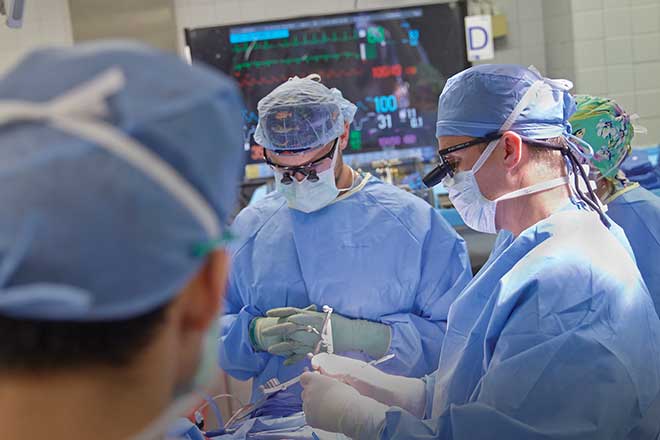“A lot of areas where we operate routinely today were felt to be no-man’s-land two or three decades ago. There were tumors that were believed to be inaccessible because they were so deep in the brain, and there were limitations even in our ability to visualize them,” says Dr. Jeroen Coppens, a SLUCare neurosurgeon at Saint Louis University Hospital.
He is the first specialist in Missouri trained to apply BrainPath technology to surgery, which allows tumors and hemorrhages to be treated deep in the brain with minimal disturbance of delicate tissues. “BrainPath uses all of today’s innovations in pre-operative imaging and other technologies to permit us to navigate through the brain into deep locations,” Coppens says. “Now the openings we need to make are smaller, and we can take a targeted approach directly to the abnormality. We do the surgery with very minimal disruption of surrounding structures, which leads to less risk, better outcomes, faster healing and shorter hospital stays.”
The adult brain weighs only 3 pounds but is packed with billions of neurons, cells that enable the feeling of sensations, control of movements, storage of memories and processing of decisions. The neurons are linked by millions of fibrous axons, some up to an inch in length, that connect through trillions of synapses.
“The brain is a little bit firmer than Jell-O,” explains Coppens, a neurosurgeon with SLUCare Physician Group. “It has crevices and fibers running through it. The cells can have very long fibers. When there are abnormalities deep in the brain, you have to go through normal structures to go to that depth. Of course, you want a method that is very minimalistic.”
It is imperative to protect the various areas of the brain as much as possible in order not to disturb key functions. “Complications related to tissue injury are dependent upon location,” Coppens says. “Some surgeries can be high risk if we are close to areas that control motor function, speech and the ability to see.”
BrainPath mitigates that risk by combining the latest capabilities in brain imaging with a surgical approach that guides surgical instruments through natural folds in tissues rather than dissecting those tissues. The technology was developed by Joseph Mark, chief technology officer and inventor of NICO Corporation in Indianapolis, and is sold by the company.
The system uses imaging techniques and computer software to guide a cylindrical cannula that is 13.5 millimeters (half an inch) in diameter. It is placed into an opening in the skull slightly smaller than a dime and guided to the abnormality by gently displacing brain tissues as it slips past them. Surgical instruments then travel through the cannula to perform the needed procedure, such as removing a tumor. Brain tissues return to their normal positions when the device is removed.
This technology is permitting neurosurgeons to explore new approaches to strokes deep within the brain, Coppens says. “We have reopened that field,” he notes. “There is hope that we may have a very significant impact by operating earlier on people who have hemorrhagic strokes. By doing a surgery that can be very targeted in an emergent setting, with very minimal disruption of the brain, we can prevent them from reaching the point where they are so devastating.” “There are a lot of encouraging results.”
Pictured: SLUCare neurosurgeon Dr. Jeroen Coppens
Photo courtesy of SLUCare Physician Group
[Neurosurgeon Dr. Jeroen Coppens practices with SLUCare Physician Group. He sees patients in the Saint Louis University Hospital West Pavilion, 3665 Vista Ave. For more information call 314.577.8715 or visit slucare.edu/brainpath.]
